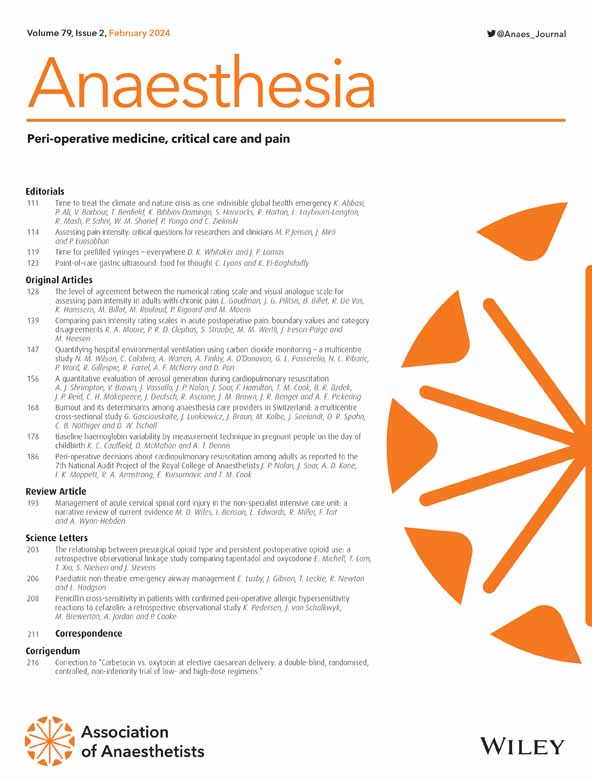上呼吸道护理点超声在困难气道管理中的应用:一项系统综述和meta分析*
IF 6.9
1区 医学
Q1 ANESTHESIOLOGY
引用次数: 0
摘要
床边筛查试验在预测困难气道中的应用是有限的。人们对超声在气道评估和管理中的作用越来越感兴趣。本系统综述和荟萃分析旨在确定各种上呼吸道护理点超声参数在预测困难气道中的诊断效用和临床应用。方法检索数据库中随机对照试验、观察性研究和5例以上病例的病例序列。结果共纳入60项研究,涉及10,580例患者,评估58项参数。对于困难的面罩通气,一项叙述性综合研究表明,舌厚的增加与气道困难发生率的增加有关。对于困难喉镜检查的预测,从皮肤到声带的距离的敏感性、特异性和接受者操作者特征曲线(AUROC)下的面积分别为0.84 (95%CI 0.74-0.91)、0.81 (95%CI 0.61-0.92)和0.87 (95%CI 0.78-0.89)(证据的高确定性)。对于气管插管困难的预测,皮肤到会珠的距离具有最高的敏感性(0.80 (95%CI 0.74-0.85))和特异性(0.86 (95%CI 0.74-0.91))(证据的高确定性),而皮肤到舌骨的距离具有最高的AUROC (0.86) (95%CI 0.73-0.92),敏感性和特异性分别为0.78 (95%CI 0.60-0.89)和0.81 (95%CI 0.63-0.91)(中等确定性证据)。与触诊相比,超声的使用与经皮气管造口术的一次通过成功率更高(优势比(95%CI) 3.9(2.1-71),(低-中等证据确定性))和环甲膜识别的改善相关(优势比(95%CI) 3.61(2.20-5.92)(中-高证据确定性)。上呼吸道护理点超声可提高对困难气道的预测;它的使用与经皮气管切开术第一次成功率的提高有关。未来的研究应侧重于评估其在高危患者群体中的应用,并结合重点病史和标准床边检查试验。本文章由计算机程序翻译,如有差异,请以英文原文为准。
Point‐of‐care ultrasound of the upper airway in difficult airway management: a systematic review and meta‐analysis*
SummaryIntroductionThe utility of bedside screening tests for the prediction of difficult airways is limited. There is growing interest in the role of point‐of‐care‐ultrasound in airway assessment and management. This systematic review and meta‐analysis aimed to determine the diagnostic utility and clinical application of various upper airway point‐of‐care‐ultrasound parameters in the prediction of difficult airways.MethodsWe searched databases for randomised controlled trials, observational studies and case series with more than five cases.ResultsIn total, 60 studies involving 10,580 patients, evaluating 58 parameters were included. For difficult facemask ventilation, a narrative synthesis showed that increased tongue thickness was associated with an increased incidence of a difficult airway. For prediction of difficult laryngoscopy, the sensitivity, specificity and area under the receiver operator characteristic curve (AUROC) for distance from‐skin‐to‐vocal‐cords were 0.84 (95%CI 0.74–0.91), 0.81 (95%CI 0.61–0.92) and 0.87 (95%CI 0.78–0.89), respectively (high certainty of evidence). For prediction of difficult tracheal intubation, distance from skin‐to‐epiglottis had the highest sensitivity (0.80 (95%CI 0.74–0.85)) and specificity (0.86 (95%CI 0.74–0.91)) (high certainty of evidence), while distance from skin‐to‐hyoid had the highest AUROC of 0.86 (95% CI 0.73–0.92), with a sensitivity and specificity of 0.78 (95%CI 0.60–0.89) and 0.81 (95%CI 0.63–0.91), respectively (moderate certainty of evidence). Ultrasound use was associated with higher first pass success in percutaneous tracheostomy (odds ratio (95%CI) 3.9 (2.1–71), (low‐moderate certainty of evidence)) and improved cricothyroid membrane identification compared with palpation (odds ratio (95%CI) 3.61 (2.20–5.92) (moderate‐high certainty of evidence)).DiscussionUpper airway point‐of‐care ultrasound may improve prediction of difficult airways; its use is associated with improved first pass success in percutaneous tracheostomy. Future research should focus on evaluating its use in combination with a focused history and standard bedside examination tests, and in at‐risk patient populations.
求助全文
通过发布文献求助,成功后即可免费获取论文全文。
去求助
来源期刊

Anaesthesia
医学-麻醉学
CiteScore
21.20
自引率
9.30%
发文量
300
审稿时长
6 months
期刊介绍:
The official journal of the Association of Anaesthetists is Anaesthesia. It is a comprehensive international publication that covers a wide range of topics. The journal focuses on general and regional anaesthesia, as well as intensive care and pain therapy. It includes original articles that have undergone peer review, covering all aspects of these fields, including research on equipment.
 求助内容:
求助内容: 应助结果提醒方式:
应助结果提醒方式:


